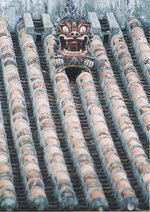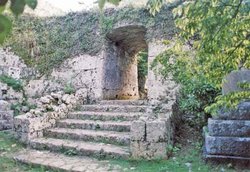Okinawa Prefecture
|
|
- This article is about the prefecture. For the city, see Okinawa, Okinawa. For the island, see Okinawa Island.
Template:Japanese prefecture Okinawa Prefecture (Japanese 沖縄県; Okinawan Uchinā) is Japan's southernmost prefecture, and consists of hundreds of islands known as The Ryūkyū Islands or Ryūkyūs, in an island chain over 1000 km long, which extends southwest from Kyūshū (the southwesternmost of Japan's main four islands) to Taiwan, although the northern islands in the chain are part of Kagoshima Prefecture. Okinawa's capital, Naha, is located in the southern part of the largest and most populous island, Okinawa Honto, which is approximately half-way between Kyūshū and Taiwan. The disputed Senkaku Islands are also administered as part of Okinawa Prefecture.
| Contents |
History
The islands that now make up Okinawa Prefecture were formerly not part of Japan, but part of an independent nation called the Ryūkyū Kingdom. Okinawa's location in the East China Sea, and relatively close proximity to China, Japan, Taiwan, and the Philippines allowed the Ryūkyū Kingdom to become a prosperous trading nation. The many castle ruins that dot the island date from this period. However, in 1609 the Japanese Satsuma clan, who controlled the region that is now Kagoshima Prefecture, invaded. Following this invasion, although the Ryūkyū Kingdom remained nominally independent, it was effectively under the control of the Satsuma. In 1879, following the Meiji restoration, the Ryūkyū Kingdom was abolished and became Okinawa Prefecture.
Following the end of World War II and the Battle of Okinawa in 1945, for 27 years Okinawa was under US administration. During this time, Okinawa's currency was the US dollar, and the US military established numerous bases on Okinawa Honto and elsewhere.
On May 15, 1972, Okinawa once again became part of Japan, although to this day the US maintains a large military presence there: more than 50,000 US military personnel and dependents, including 17,600 Marines, are still based there. While they provide a source of revenue for the island's 1.3 million residents they are also a source of considerable tension.
See also Ryukyuan history.
Language & Culture

Having historically been a separate nation (and the Ryūkyū Kingdom having had closer ties with China than with Japan), Okinawan language and culture differ considerably from that of mainland Japan. There remain numerous Ryukyuan languages which are more-or-less incomprehensible to Japanese speakers. These languages are in decline as the Japanese government has encouraged the use of Standard Japanese.
Due to its location and history, Okinawa is also more ethnically diverse than other parts of Japan. Okinawans are a unique blend of Malay from Formosa and Philippines, Chinese from China, and Japanese (Yamato) from Japan. Culturally, they are closer to Filipino and Chinese than mainland Japanese.
OkinawaPottery.jpg
Perhaps Okinawa's most famous cultural export is karate, probably a product of the close ties with, and influence of China on Okinawan culture. Karate is thought to be a synthesis of Chinese kung fu with traditional Okinawan martial arts. A ban on weapons in Okinawa for two long periods in its history also very likely contributed to its development.
Another traditional Okinawan product that owes its existence to Okinawa's trading history is awamori—an Okinawan distilled spirit made from indica rice imported from Thailand.
The people of Okinawa maintain a strong tradition of pottery.
Other prominent examples of Okinawan culture include the sanshin—a three-stringed Okinawan instrument, closely related to the Chinese sanxian, and ancestor of the Japanese shamisen, somewhat similar to a banjo. Its body is often bound with snakeskin (from pythons, imported from elsewhere in Asia, rather than from Okinawa's poisonous habu, which are too small for this purpose, but which are sometimes used to make habu awamori...)—and the eisa dance—a traditional drumming dance. A traditional craft, the fabric named bingata, is made in workshops on the main island and elsewhere.
Climate and Nature
The island is largely composed of coral rock, and rainwater filtering through that coral has given the island many caves, which played an important role in the Battle of Okinawa. Gyokusendo, an extensive limestone cave in the southern part of Okinawa Honto, is a popular tourist attraction.
Okinawa is said to have the most beautiful beaches in all of Japan and normally enjoys above 20 degree Celsius weather for most of the year. Many coral reefs are found in this region of Japan and wildlife is abundant. Sea turtles return yearly to the southern islands of Okinawa to lay their eggs. The summer months carry warnings to swimmers regarding poisonous jellyfish and other dangerous sea creatures. Okinawa is a major producer of sugar cane, pineapples, papayas and other tropical fruits.
Okinawa has a very large proportion of population living to one hundred years of age. It is attributed to their healthy diet rich in vegetables and fish.
Architecture
Okinawa has many remains of a unique type of castle or fortress called Gusuku. These are believed to be the predecessors of Japan's castles.
Whereas most homes in Japan are made with wood and allow free-flow of air to combat humidity, typical modern homes in Okinawa are made from concrete with barred windows (protection from flying plant matter) to deal with regular typhoons. Roofs are also designed with strong winds in mind, with each tile cemented on and not merely layered as seen with many homes elsewhere in Japan.
Many roofs also display a roundish statue of a lion or dragon, called a shisa, which is said to protect the home from danger. Roofs are typically red in color and are inspired by Chinese design.
Major islands
Map-okinawa-pref.png
Okinawa's inhabited islands are typically divided into three geographical archipelagos. From northeast to southwest:
- Okinawa Islands (沖縄諸島 Okinawa-shotō)
- Ie-jima - 伊江島
- Kume - 久米島
- Okinawa Honto - 沖縄本島
- Miyako Islands (宮古諸島 Miyako-shotō)
- Miyako-jima - 宮古島
- Yaeyama Islands (八重山諸島 Yaeyama-shotō)
Cities
- Ginowan, Okinawa
- Gushikawa, Okinawa
- Hirara, Okinawa
- Ishigaki, Okinawa
- Ishikawa, Okinawa
- Itoman, Okinawa
- Nago, Okinawa
- Naha, Okinawa (capital)
- Okinawa, Okinawa
- Urasoe, Okinawa
Towns
- Chatan, Okinawa
- Gusukebe, Okinawa
- Haebaru, Okinawa
- Irabu, Okinawa
- Ishikawa, Okinawa
- Kadena, Okinawa
- Katsuren, Okinawa
- Kin, Okinawa
- Kochinda, Okinawa
- Motobu, Okinawa
- Nishihara, Okinawa
- Sashiki, Okinawa
- Shimoji, Okinawa
- Taketomi, Okinawa
- Yonabaru, Okinawa
- Yonaguni, Okinawa
- Yonashiro, Okinawa
Districts
United States Military Installations
- Kadena Air Base
- Marine Corps Base Camp Smedley D. Butler
- Naha Military Port
- Naval Facility White Beach
- Naval Hospital, Okinawa
- Torii Station
See also
External links
- Okinawa Prefecture Official Home-page (http://www.pref.okinawa.jp/english/)
- Ryukyu Cultural Archives (http://rca.open.ed.jp/web_e/)
- mahae plus - Okinawa Travel Information (http://www.ocvb.or.jp/index.php?*current=Page_Header&action=Top_Page&mode=isel&lang=en&name=header_en)
- Wonder Okinawa (http://www.wonder-okinawa.jp/index_en.jsp)
- IDB-IIC Okinawa 2005 (http://www.idb-okinawa2005.jp/)
- Okinawan religion (http://www.lifeinhim.net/religion.htm)
- Marine Corps Bases Japan Home Page (http://www.okinawa.usmc.mil/)
| edit (http://en.wikipedia.org/w/wiki.phtml?title=Template:Japan&action=edit) | Prefectures of Japan | Missing image Japan_flag_large.png Flag of Japan |
|---|---|---|
| Aichi | Akita | Aomori | Chiba | Ehime | Fukui | Fukuoka | Fukushima | Gifu | Gunma | Hiroshima | Hokkaido | Hyogo | Ibaraki | Ishikawa | Iwate | Kagawa | Kagoshima | Kanagawa | Kochi | Kumamoto | Kyoto | Mie | Miyagi | Miyazaki | Nagano | Nagasaki | Nara | Niigata | Oita | Okayama | Okinawa | Osaka | Saga | Saitama | Shiga | Shimane | Shizuoka | Tochigi | Tokushima | Tokyo | Tottori | Toyama | Wakayama | Yamagata | Yamaguchi | Yamanashi | ||
| Regions of Japan | ||
| Hokkaido | Tohoku | Kanto | Chubu (Hokuriku - Koshinetsu - Tokai) | Kansai | Chugoku | Shikoku | Kyushu | ||
| Major Cities | ||
| 23 wards of Tokyo | Chiba | Fukuoka | Hiroshima | Kawasaki | Kitakyushu | Kobe | Kyoto | Nagoya | Osaka | Saitama | Sapporo | Sendai | Shizuoka | Yokohama | ||
es:Okinawa fr:Préfecture d'Okinawa ko:오키나와 현 id:Prefektur Okinawa he:אוקינאווה ja:沖縄県 pl:Okinawa pt:Okinawa sv:Okinawa prefektur zh:冲绳县


